The performance of Next Unit of Computing (NUC) barebone computers has slowly become comparable to standard desktop PCs at a fraction of the size. In the past year or two Intel have moved their NUC offerings into the gaming sector, first with the Skull Canyon and now with the Hades Canyon.
Gaming PCs have traditionally been extremely large boxes with large costs involved. Now with the Hades Canyon Intel have something they think is comparable in performance to the much more expensive and much larger traditional gaming PC. With a multitude of ports and some impressive specs it may well be what they say it is, a gaming PC replacement.
I am in the process of building a house and am looking for a high end PC for not just gaming but video editing and would rather not have one that takes up a lot of room in my new study. For this reason I have had my eye on the Intel NUCs for a while. When the opportunity to try out a Hades Canyon came up, I jumped at the chance even with it being a bit out of my comfort zone. It sounds like the perfect solution (albeit a bit of overkill, but I refuse the acknowledge that is actually a thing or even a word) for my needs in my new study.
| Pros | Cons |
|---|---|
| Small form factor | Not quite gaming PC powerful |
| Barebones – DIY | Expensive |
| Large number of ports | Large AC adapter |
| Great design |
TL;DR
The Intel Hades Canyon NUC8i7HVK is an extremely attractive NUC which performs at a very high level. When you factor in the size of the NUC the number of ports included is impressive, as is the specs it is possible to include.
Priced around $1300 for the barebones which does not include any RAM or hard drives it is on the more expensive side. By the time you add in a SSD or two and a couple of channels of RAM it will be around the $1600 mark. Definitely not cheap but considering it is a desktop gaming PC replacement in a tiny package, it is not a bad deal, especially if space is of a premium.
Are the specs good enough for gaming?
The Hades Canyon arrives with it’s purpose built processor, an Intel Core i7-8809G, which has a built in AMD graphics chip (Radeon RX Vega M GH). Intel and AMD partnership, who would have thought it? The GPU has 4GB of HBM2 memory which means it can even be used to power VR experiences. Not bad for a NUC.
The rest of the specs in the Hades Canyon are up to you. It is sold as a barebones kit and you can decide for yourself what you want to put in it. It supports 2 x M.2 SSDs and up to 32GB of RAM via two memory channels.
Inside the review unit was 16GB of RAM, a M.2 120GB SSD to run the OS and a 512GB M.2 SSD for storage. Of course you can go higher than this if you wish to as mentioned above.
The specs themselves should be good enough for gaming according to Intel and there is no reason why not. Last year at PAX2018 the organisers used 100 linked Intel Skull Canyon NUCs to simultaneously run Fortnite competitions (with 100 competitors). The Skull Canyon is the predecessor to the Hades Canyon and if that could run if comfortably you would expect the Hades Canyon to do so and more.
The NUC itself is bigger than most, if not all NUCs, but is still relatively small. At 21mm x 142mm x 39mm it can still sit on a desktop without taking up much room.
Inside the NUC supports Bluetooth 4.2 and Wi-Fi 802.11 ac. It is disappointing there is no Bluetooth 5.0 support but at this stage few devices support that anyway.
Ports
The ports are numerous with the total of the ports including 6 USB ports (2 x front), front and rear HDMI ports, 2 x thunderbolt3 ports on the rear and a USB-C port on the front, an SD slot, 2 Gigabit ethernet ports, 2 mini-DP ports, a headphone jack and a TOSLINK optical output. So many ports.
For myself the number of ports is overkill, if that really is indeed a word. You could easily run multiple monitors and have multiple inputs at the same time. The NUC supports up to six 4K monitor outputs if you should so desire.

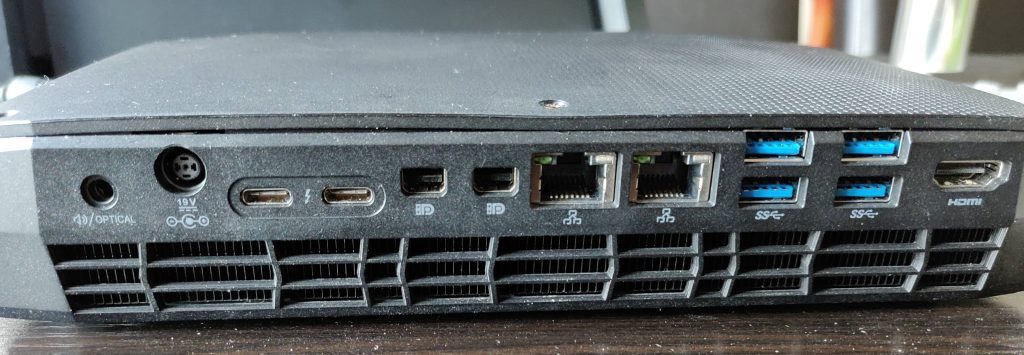
The design is striking
While off the design of the Hades Canyon is a small basic plain box. Turn it on and the magic happens. The top of the box lights up displaying an evil-looking skull with red eyes. The eyes turn blue when in standby mode. You are apparently able to customise the lighting or turn it off if you wish.
The design of the Hades Canyon is the best thing about it. Not only is it small but it is a great looking device. It is possibly twice as large as most NUCs but is still an impressively compact for what it holds.
Taking the unit apart is quite easy and just the removal of a few screws – firstly the six torx screws (tool included in the box) followed by one with a basic Philips head screwdriver. Inside the NUC you can then add whatever RAM and SSDs you want to.
One negative about the device is the size of the AC adapter. It is nearly as big as the NUC itself and is one of the bigger adapters I have ever seen. They really should try and shrink this for the next version of this NUC.
Is the performance gaming standard?
The Hades Canyon NUC is as quiet as a mouse. The fans are not overly loud and when just running everyday tasks I couldn’t even hear them. While running games and benchmarks they kicked in more but still made very little noise. At the same time the heat emanating from the NUC is extremely little so the fans are doing their job and the NUC itself is doing well with heat dissipation.
As for benchmarks the NUC performed extremely well with results towards the top end of other gaming PCs. I ran it through a few benchmarks and even with other CPU activity in the background it achieved decent results.
“With a gaming score of 76.5% this CPUs suitability for 3D gaming is very good.”
Rather than reinvent the wheel we have used, with permission, the results from a friend of Ausdroid, Fergus Halliday from PC World (you can and probably should also read his review here).
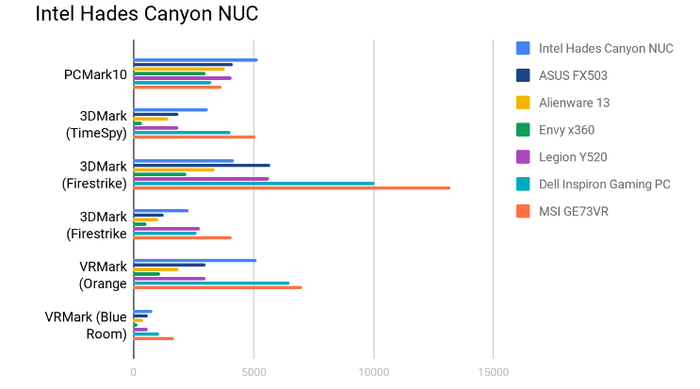
As for real world performance every game I threw at it worked well without any glitches. Fortnite, Diablo, Assassin’s Creed and a couple others ran well enough for me – although I am definitely not a high end gamer. My 10yo was telling me that Fortnite ran better on his PS4 than on this but only barely. I was as bad at Fortnite on this as I am on the PS4 so for me it seemed the same.
The rig is also meant to be able run VR games which many reviewers have struggled to be able to do seamlessly. On paper it should be able to do them but some have found it to not quite be up to the task. There is also a display port lacking which some VR headsets (HTC Vive) require.
The games I tested were run on a 27in ultrawide LG 1080P monitor so it is not like I was running them at a high resolution but they still ran well without any glitches. To test it on a 4K display I hooked it up to my Sony TV and once again it performed well. You could tell a difference in the smoothness of the games from the lower resolution monitor to this one but it was not massive.
For something in such a small package to perform nearly as well as high end PCs which take up a large amount of room is astonishing and with this line only in its second iteration it shows a bright future for the gaming NUC.
Premium performance at a premium price
The Hades Canyon arrives as a barebones kit and is not cheap. It is an impressive piece of engineering being able to pack so much into a small form factor. The hardware it does arrive with is impressive and with an 8th gen Core i7 onboard with a heap of ports and a great design and as such it arrives at an impressive price.
The Hades Canyon is priced at around $1350AU these days so it is not cheap. For that you get the barebones kit. You will then have to purchase some RAM and an SSD or two as well as an operating system if you are planning on running Windows 10 on it. Factor all that in and you won’t get away for less than $1600.
For that price you are getting towards the PC gaming range of pricing but the big thing is size. PC gaming rigs are often big things which take up a lot of room. This is the power of such a rig in a compact package and you pay a premium for that.
So should you buy one?
The Intel Hades Canyon is a powerful PC in a very small package. It may be twice as large as most NUCs but it is still a fraction of the size of most PCs, especially gaming PCs. Sure it is expensive but except for the most serious PC gamer this will accomplish anything you want it to.
The barebones kit is not cheap but you can then customise it yourself with however much RAM and storage you want. In the end you have a high end PC which looks good, runs extremely well and fits into a tiny space.
In the end you have to decide if you want a PC that runs everything you want it to but can hide away basically out of sight then this is something you should think about getting. The best test of a review unit is whether the reviewer puts their money where their mouth is — I will be buying one for my new study when the house is finished. Enough said.



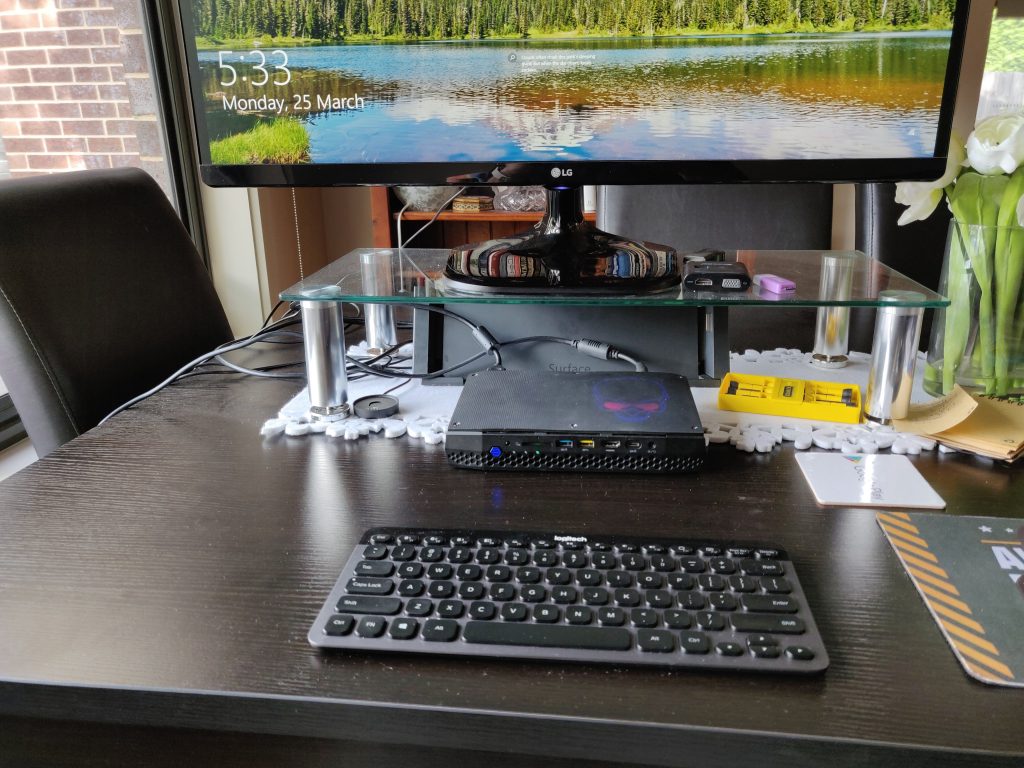


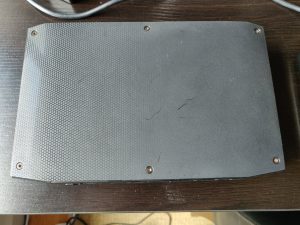

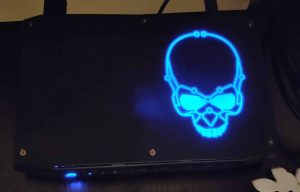



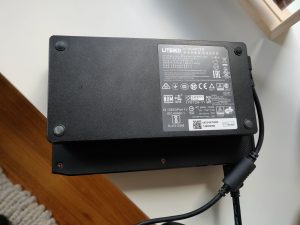





I’m not sure where you got the $1300 price. I think $899 was the MSRP for it originally, but picked it up for about $750 on Amazon (which appears to have been temporary: it’s now back to about $850). $1300 to $1500 appears to be the price if you bought it pre-built with ram, HD, and windows 10 pro. In my case it cost about $900 after ram and HD, but I already had a windows license. I’d also disagree that it’s not quite a gaming PC. It’s specs are entry level, sure, but it’s AMD GPU clocks in higher… Read more »
I was considering buying this because really it’s amazing in size and it’s also way more portable then a massive tower. I understand having a tower has it’s benefits but dam this sized machine is how the future should be, in saying that it is alot of money so I’m thinking about the rumored Ghost Canyon they say Intel is bringing teraflop integrated graphics to 10nm chips in 2019 and the Ghost Canyon with be available with 4, 6 and 8 core options with room for a dedicated GPU ? yes sounds like the size of this thing maybe the… Read more »
I’ve owned one of these for a few months now. I absolutely love the thing. Plays 4k HDR content in my lounge without breaking a sweat. Also plays GTA5 in 1080p with high graphics setting, again with no trouble. The light-up skull is barely noticeable, even when watching a movie at night with the lights off. Of course you can get better bang for your buck, but this tiny thing was worth it to me.
Sorry, 4C/8T and inadequate cooling and no upgrade path for 1300, pass. Not to mention the GPU is also woefully behind in 2019. It can’t even catch a GTX1060. Equivalent cost mITX case might be larger but I’m not really seeing any remotely common use-cases where a large shoebox size (mITX) vs a hardback book (this NUC) size matters? Esp if graphics is important you don’t want to be tied to the original card. Does anyone really care if their HTPC or gaming box is a little larger, for a 1300 budget you can get quite a nice mITX combo… Read more »